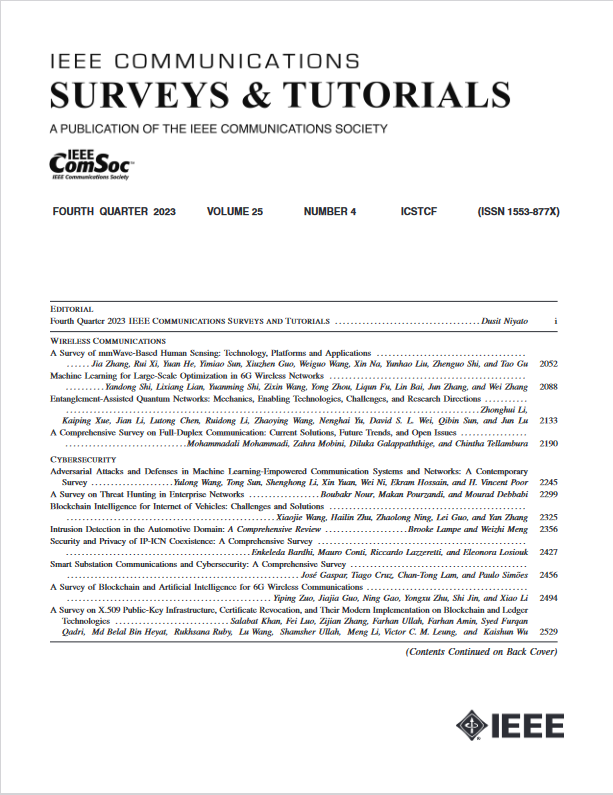关于大规模无线网络中应用的渗透理论的教程与研究
IF 34.4
1区 计算机科学
Q1 COMPUTER SCIENCE, INFORMATION SYSTEMS
引用次数: 0
摘要
连接性是一项重要的关键性能指标,也是大规模无线网络的研究重点。由于电磁波的路径损耗衰减,直接无线连接仅限于近距离设备。不过,远距离设备之间仍可通过一连串连续的多跳通信链路实现连接,从而在无线特设网络中进行路由选择并传播合法信息。多跳连接也是物联网(IoT)和网络物理系统(CPS)数据聚合的基础。但另一方面,多跳无线传输增加了被窃听的可能性,使恶意网络攻击成为可能。因此,需要具有安全意识的网络连接来维护通信隐私,检测和隔离恶意设备,阻止非法流量(如病毒、蠕虫、伪造数据、非法控制等)的传播。在 5G 及以后的网络中,由于物联网和 CPS 的激增,大量无线设备可以直接通信(如设备到设备、机器到机器和车辆到车辆通信),因此必须在连接性、隐私和安全性之间实现复杂的平衡。在这方面,图论是建立网络物理拓扑模型的基础数学工具。其中,随机几何图(RGG)捕捉了空间分布设备之间固有的随机位置和无线互连。然后利用渗流理论来描述和控制网络图上的远距离多跳连接。最近,RGG 上的渗滤理论被广泛用于研究几类无线网络的连通性、隐私性和安全性。在物联网/CPS 时代,预计渗滤理论的影响和应用将进一步增加,这也是本教程的动机所在。为此,我们首先介绍图理论和渗流理论在无线网络中的初步应用。接下来,我们将概述并解释它们在各类无线网络中的应用。本文章由计算机程序翻译,如有差异,请以英文原文为准。
A Tutorial-Cum-Survey on Percolation Theory With Applications in Large-Scale Wireless Networks
Connectivity is an important key performance indicator and a focal point of research in large-scale wireless networks. Due to path-loss attenuation of electromagnetic waves, direct wireless connectivity is limited to proximate devices. Nevertheless, connectivity among distant devices can still be attained through a sequence of consecutive multi-hop communication links, which enables routing and disseminating legitimate information across wireless ad hoc networks. Multi-hop connectivity is also foundational for data aggregation in the Internet of things (IoT) and cyberphysical systems (CPS). On the downside, multi-hop wireless transmissions increase susceptibility to eavesdropping and enable malicious network attacks. Hence, security-aware network connectivity is required to maintain communication privacy, detect and isolate malicious devices, and thwart the spreading of illegitimate traffic (e.g., viruses, worms, falsified data, illegitimate control, etc.). In 5G and beyond networks, an intricate balance between connectivity, privacy, and security is a necessity due to the proliferating IoT and CPS, which are featured with massive number of wireless devices that can directly communicate together (e.g., device-to-device, machine-to-machine, and vehicle-to-vehicle communication). In this regards, graph theory represents a foundational mathematical tool to model the network physical topology. In particular, random geometric graphs (RGGs) capture the inherently random locations and wireless interconnections among the spatially distributed devices. Percolation theory is then utilized to characterize and control distant multi-hop connectivity on network graphs. Recently, percolation theory over RGGs has been widely utilized to study connectivity, privacy, and security of several types of wireless networks. The impact and utilization of percolation theory are expected to further increase in the IoT/CPS era, which motivates this tutorial. Towards this end, we first introduce the preliminaries of graph and percolation theories in the context of wireless networks. Next, we overview and explain their application to various types of wireless networks.
求助全文
通过发布文献求助,成功后即可免费获取论文全文。
去求助
来源期刊

IEEE Communications Surveys and Tutorials
COMPUTER SCIENCE, INFORMATION SYSTEMS-TELECOMMUNICATIONS
CiteScore
80.20
自引率
2.50%
发文量
84
审稿时长
6 months
期刊介绍:
IEEE Communications Surveys & Tutorials is an online journal published by the IEEE Communications Society for tutorials and surveys covering all aspects of the communications field. Telecommunications technology is progressing at a rapid pace, and the IEEE Communications Society is committed to providing researchers and other professionals the information and tools to stay abreast. IEEE Communications Surveys and Tutorials focuses on integrating and adding understanding to the existing literature on communications, putting results in context. Whether searching for in-depth information about a familiar area or an introduction into a new area, IEEE Communications Surveys & Tutorials aims to be the premier source of peer-reviewed, comprehensive tutorials and surveys, and pointers to further sources. IEEE Communications Surveys & Tutorials publishes only articles exclusively written for IEEE Communications Surveys & Tutorials and go through a rigorous review process before their publication in the quarterly issues.
A tutorial article in the IEEE Communications Surveys & Tutorials should be designed to help the reader to become familiar with and learn something specific about a chosen topic. In contrast, the term survey, as applied here, is defined to mean a survey of the literature. A survey article in IEEE Communications Surveys & Tutorials should provide a comprehensive review of developments in a selected area, covering its development from its inception to its current state and beyond, and illustrating its development through liberal citations from the literature. Both tutorials and surveys should be tutorial in nature and should be written in a style comprehensible to readers outside the specialty of the article.
 求助内容:
求助内容: 应助结果提醒方式:
应助结果提醒方式:


